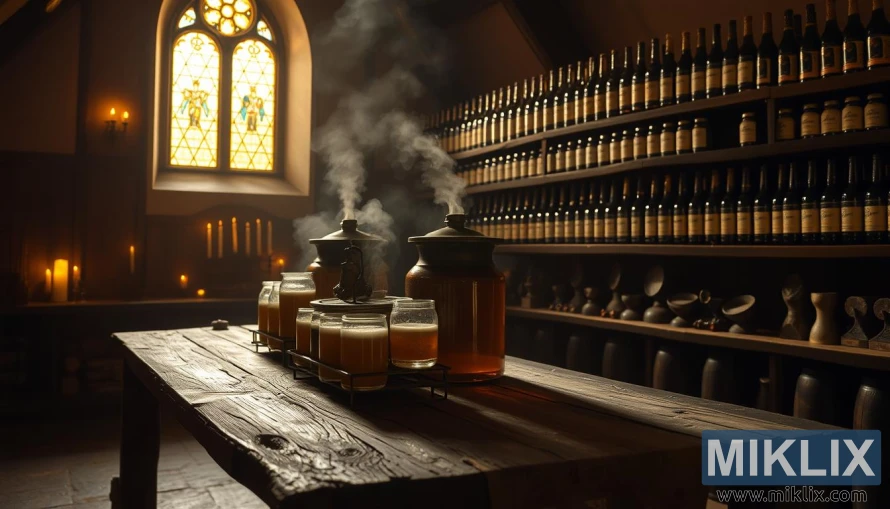Image: Sanctum of Fermentation: The Monastic Art of Brewing
Published: November 4, 2025 at 8:38:03 AM UTC
Inside a candlelit monastery, steaming vessels and rows of aging bottles capture the sacred craft of monastic brewing, where patience and devotion transform humble ingredients into liquid art.
Within the quiet stone walls of a monastery, a golden warmth pervades the air, cast by flickering candlelight and the soft hues filtering through a stained glass window. The atmosphere is one of timeless devotion—a sanctuary where light, scent, and sound merge into a single meditative harmony. At the center of this tranquil space, a large wooden table stretches beneath the glow, its surface scarred and weathered by decades of faithful labor. Resting upon it are several fermentation vessels of varying size and shape—some large, earthen jars with lids that release gentle wisps of steam, others smaller glass containers filled with frothy, golden liquid, still bubbling with quiet energy. Each vessel seems to pulse with life, the invisible work of yeast transforming simple wort into a sacred brew.
The air is rich with aroma, a heady mix of malted grain and warm spice—the yeast releasing subtle hints of clove and banana, mingling with the sweet, woody undertones of aging oak and candle wax. It is an olfactory hymn, both earthly and divine, that speaks of centuries of monastic tradition. This is no mere kitchen or laboratory—it is a place of contemplation, where brewing becomes an act of reverence, and fermentation a slow meditation on transformation itself. The monks who tend to these vessels are unseen, yet their discipline and patience linger in every detail: the careful arrangement of jars, the evenness of the flames, the order of tools placed neatly along the shelves.
In the background, two great walls of shelves stand as silent witnesses to this ongoing ritual. One side is lined with neatly arranged bottles, their dark glass glimmering faintly in the soft light. Each label, carefully inscribed, hints at complexity—amber ales, dark quadrupels, and spiced tripels that have matured in the monastery’s cool cellars for seasons or years. Beneath these, rows of ceramic vessels and wooden goblets rest, awaiting the day when their contents will be shared among the brethren or offered to visitors as tokens of the monks’ devotion to both craft and community. Every object in the room, from the rough grain of the table to the ornate stained glass above, tells of a deep continuity between faith, labor, and creation.
The window itself bathes the scene in ethereal light, its intricate panes depicting saints and symbols of harvest and abundance—visual reminders of the divine inspiration behind this humble work. The light filters through in soft hues of amber, gold, and crimson, echoing the tones of the brewing liquid below. The interplay of this illumination and the candle flames creates an almost sacred chiaroscuro, transforming the workshop into a chapel of fermentation.
The entire composition radiates quiet anticipation. The steam rising from the vessels curls upward like incense, a visible prayer to the unseen forces at play. Here, brewing is not an industrial process but a living dialogue between human care and natural mystery. The monks’ ancient art persists not for profit or efficiency, but for understanding—the pursuit of harmony between creation and creator, between simplicity and perfection. In this sanctum of fermentation, time itself seems to slow, the humble act of brewing elevated into a reflection of spiritual patience and devotion, where each bubbling vessel holds within it both the science of transformation and the mystery of faith.
The image is related to: Fermenting Beer with CellarScience Monk Yeast

